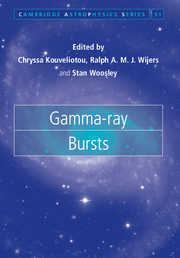Book contents
- Frontmatter
- Contents
- List of contributors
- Prologue
- 1 The discovery of the gamma-ray burst phenomenon
- 2 Instrumental principles
- 3 The BATSE era
- 4 The cosmological era
- 5 The Swift era
- 6 Discoveries enabled by multiwavelength afterglow observations of gamma-ray bursts
- 7 Prompt emission from gamma-ray bursts
- 8 Basic gamma-ray burst afterglows
- 9 The GRB–supernova connection
- 10 Models for gamma-ray burst progenitors and central engines
- 11 Jets and gamma-ray burst unification schemes
- 12 High-energy cosmic rays and neutrinos
- 13 Long gamma-ray burst host galaxies and their environments
- 14 Gamma-ray burst cosmology
- 15 Epilogue
- Indix
- Plate section
- References
5 - The Swift era
Published online by Cambridge University Press: 05 December 2012
- Frontmatter
- Contents
- List of contributors
- Prologue
- 1 The discovery of the gamma-ray burst phenomenon
- 2 Instrumental principles
- 3 The BATSE era
- 4 The cosmological era
- 5 The Swift era
- 6 Discoveries enabled by multiwavelength afterglow observations of gamma-ray bursts
- 7 Prompt emission from gamma-ray bursts
- 8 Basic gamma-ray burst afterglows
- 9 The GRB–supernova connection
- 10 Models for gamma-ray burst progenitors and central engines
- 11 Jets and gamma-ray burst unification schemes
- 12 High-energy cosmic rays and neutrinos
- 13 Long gamma-ray burst host galaxies and their environments
- 14 Gamma-ray burst cosmology
- 15 Epilogue
- Indix
- Plate section
- References
Summary
Introduction
The study of gamma-ray bursts (GRBs) remains highly dependent on the capabilities of the observatories that carry out the measurements. The large detector size of BATSE produced an impressively large sample of GRBs for duration and sky distribution studies. The burst localization and repointing capabilities of BeppoSAX led to breakthroughs in host and progenitor understanding. The next phase in our understanding of GRBs is being provided by the Swift mission. In this chapter we discuss the capabilities and findings of the Swift mission and their relevance to our understanding of GRBs. We also examine what is being learned about star formation, supernovae, and the early Universe from the new results. In each section of the chapter, we close with a discussion of the new questions and issues raised by the Swift findings.
The Swift observatory
Swift (Gehrels et al. 2004) carries three instruments: a wide-field Burst Alert Telescope (BAT; Barthelmy et al. 2005a) that detects GRBs and positions them to arcminute accuracy, a narrow-field X-Ray Telescope (XRT; Burrows et al. 2005a) and a UV–Optical Telescope (UVOT; Roming et al. 2005) that observe their afterglows and determine positions to arcsecond accuracy, all within about 2 minutes. BAT is a coded aperture hard X-ray (15–350 keV) imager with 0.5 m2 of CdZnTe detectors (32 000 individual sensors; ~2400 cm2 effective area at 20 keV including mask occultation) and a 1.4 sr half-coded field of view.
- Type
- Chapter
- Information
- Gamma-ray Bursts , pp. 73 - 90Publisher: Cambridge University PressPrint publication year: 2012



